Back الكنديين الفلبينيين ARZ Philippino-Canadiens French Filipina Kanada ID 필리핀계 캐나다인 Korean 菲律賓裔加拿大人 Chinese
This article has multiple issues. Please help improve it or discuss these issues on the talk page. (Learn how and when to remove these messages)
|
 Filipino ancestry % in Canada (2021) | |
| Total population | |
|---|---|
| 957,355[1] 2.58% of the Canadian population (2021) | |
| Regions with significant populations | |
| Toronto, Winnipeg, Calgary, Edmonton, Vancouver | |
| 363,650 (2.6%) | |
| 216,710 (5.2%) | |
| 174,280 (3.5%) | |
| 94,315 (7.2%) | |
| 44,885 (0.5%) | |
| 43,755 (4.0%) | |
| Languages | |
| English (Canadian, Philippine), Canadian French, Tagalog (Filipino), Visayan languages, Ilocano, Kapampangan, and other languages of the Philippines | |
| Religion | |
| Roman Catholicism, Protestantism, Iglesia ni Cristo Minority: Islam and Irreligion | |
| Related ethnic groups | |
| Filipino Americans | |
The Filipino Canadians (French: Canadiennes d'origine philippine); (Filipino: Mga Filipinong Kanadyan/Kanadian) are Canadians who have a Filipino descent or ethnicity. The Filipino Canadians is the second largest subgroup of the overseas Filipinos, surpassed only by the United States, and one of the fastest-growing minority in Canada.
Only a small population of Filipinos lived in Canada until the late 20th century. At the 2016 Canadian census, 851,410 people of Filipino descent lived in Canada, mostly in urban areas. The majority of Filipino Canadians speak Tagalog. Filipino Canadians are the third-largest Asian Canadian group in the nation after the Indian and Chinese communities. They are also the largest group from Southeast Asia in the country. Between the 2011 and 2016 censuses, the Filipino community in Canada grew from 702,200 to 820,100, a growth of about 7%, compared to the rest of Canada, which grew by 5% during the same time period.
By the 2021 census, Filipino Canadians enumerated 957,355, or 2.58% of the total population, further displaying the community's rapid growth.[2]
- ^ Immigrant population in Canada, 2016 Census of Population, Statistics Canada, October 25, 2017, retrieved November 3, 2017
- ^ Government of Canada, Statistics Canada (February 9, 2022). "Profile table, Census Profile, 2021 Census of Population - Canada [Country]". www12.statcan.gc.ca. Retrieved October 26, 2022.